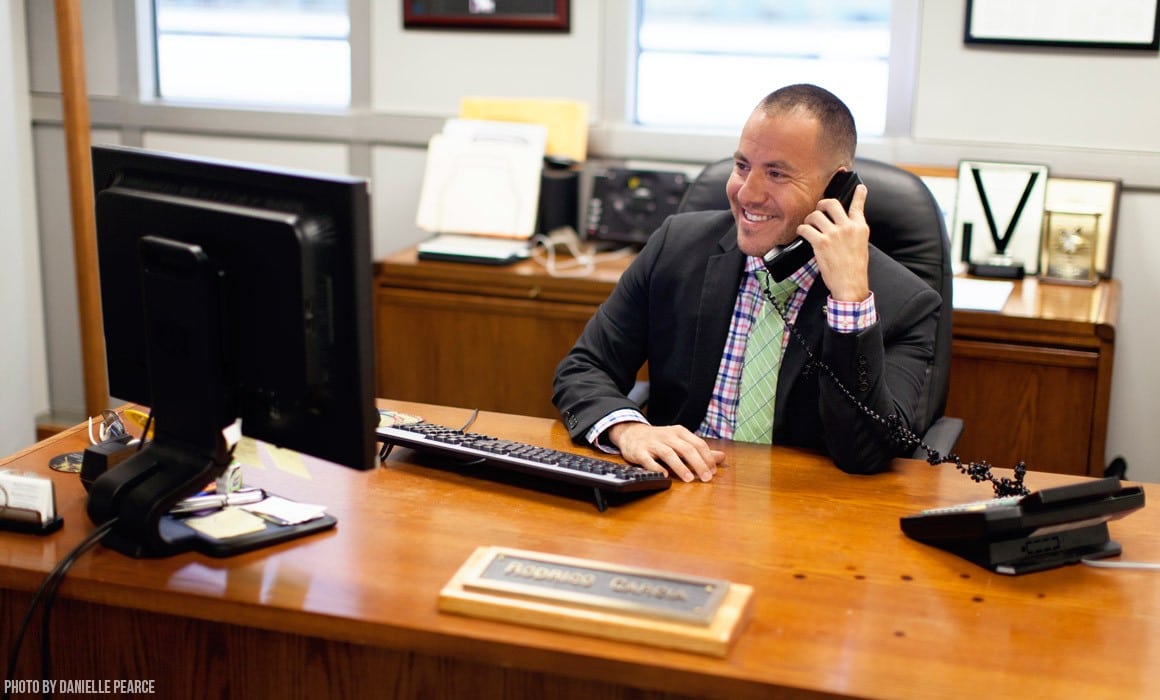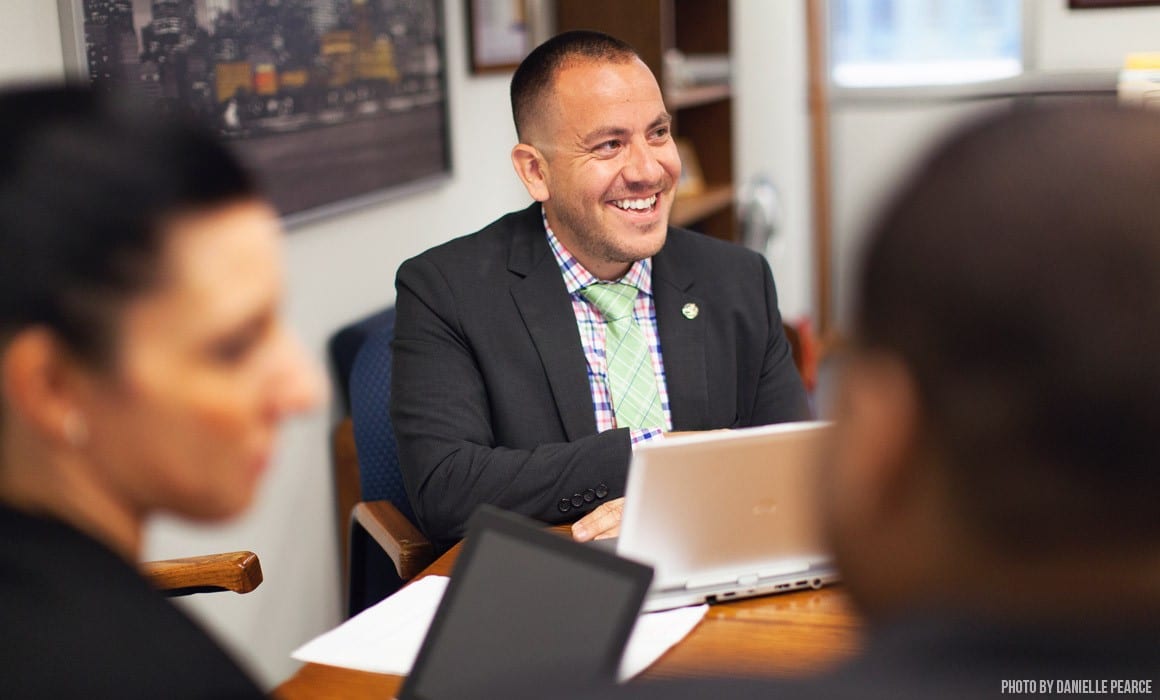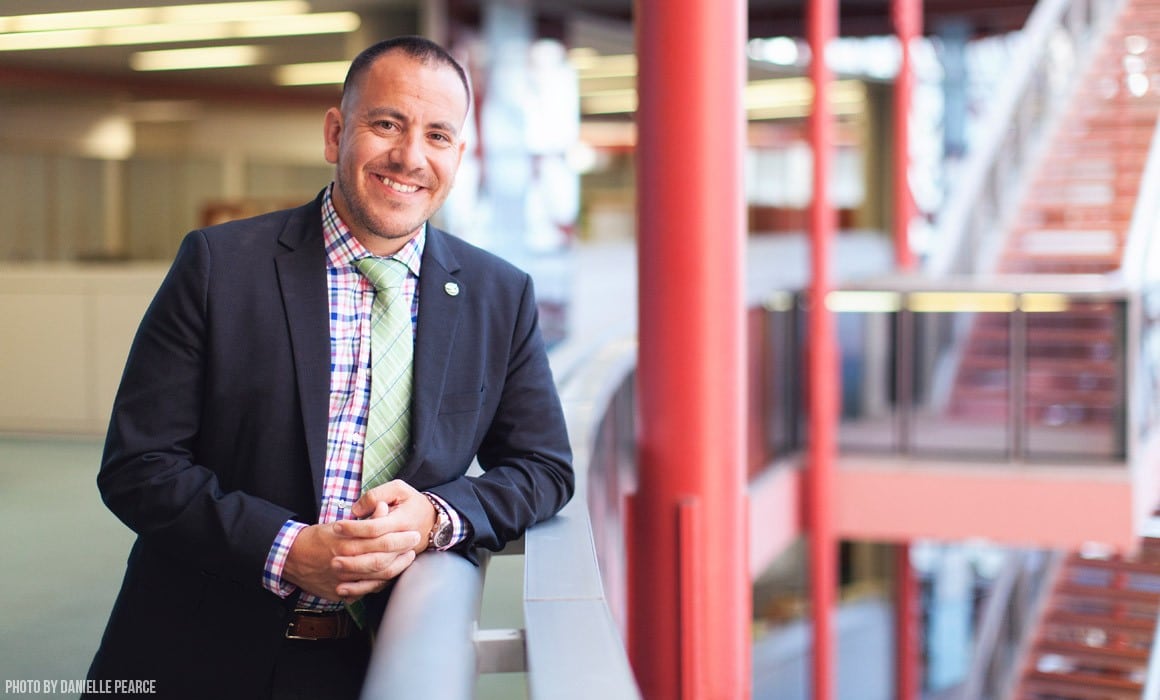What is the new American Dream? For some it is being debt free, for others it is having a stable job, but for Rodrigo Garcia, it is serving his country to ensure the safety and prosperity of his fellow citizens.
At 33 years old, Rodrigo became the youngest Chief Investment and Financial Officer for the State of Illinois when he accepted the position in January of 2015. He currently oversees $24-27 billion worth of assets, and by the time he leaves office (within four years), his management funds are estimated to mature to $40 billion.
MiLLENNiAL met up with Rodrigo at the State Treasurer’s Office in Chicago to learn how a kid from the Southside who served three tours in Iraq and Afghanistan would return to build a career in state policy and finance.
Walking into a large executive office, it was clear by the look of the nameplate on his desk, Rodrigo was the man in charge. Greeting us with a strong handshake and pleasant smile, he stood confident yet relaxed. This was his newly decreed territory and he was honored to share his story.
From Little Village to Anbar
Growing up in the gritty Chicago neighborhood of Little Village, Rodrigo was raised in a Mexican-American family of six. “Little Village is a predominantly Mexican neighborhood with first, second and third generation born Americans, mostly blue collar and low income workers,” he tells us. His parents were factory workers who taught him the meaning of hard work and perseverance.
“I knew I wanted to do something of service for this great country.”
As a teenager, Rodrigo put this lesson into practice when his father hurt his back on the job and had to take a leave of absence, forcing the family onto government assistance. But having a father who took pride in providing for his family, he soon purchased an old 1964 Ford pickup truck with the intention of collecting and selling scrap metal. Rodrigo and his brother would help their father locate old equipment and parts, and “on a weekly basis we would make about $250.00” until his father was able to return to work.
By the time Rodrigo was 18, he saw the military as a path to a stable career. As he puts it, Little Village, “wasn’t the most conducive to grow as an individual…I wanted to provide myself with additional options for my career. And I knew I wanted to do something of service for this great country,” he says.
Just a year prior to 9-11, Rodrigo joined the Marine Corps with the intention of escaping the bad influences that plagued his childhood neighborhood. “The country hadn’t been to war in at least a decade. I had no intention of actually fighting.” But when the call came, Rodrigo proudly stood by his brothers in three deployments to Iraq and Afghanistan from 2002-2005.
The Night Watch that Sparked a Calling in Finance
It was 2004 when Rodrigo served in Anbar, Iraq. While on night watch, he would often get lost in conversation discussing finance and investment strategy with his fellow soldiers. The only experience he had with finance up to that point was in high school when he played a stock simulation game.
While the task seemed like incidental fun at the time, “I realized that I really enjoyed spotting different trends and translating those trends into companies to invest in,” he explains. Flash forward years later, and Rodrigo is encouraged by his military peers to study the topic.
“You’re going to laugh…the first book I bought was Investments for Dummies, which I then followed up with The Complete Idiot’s Guide to Investments.” After the first two books, he tackled Securities Analysis, the 1934 classic written by Benjamin Graham, the Columbia professor Warren Buffet credits for his knowledge of business.
When he left the military in 2006, Rodrigo decided to devote his B.S. and M.B.A to learning finance. But when he left the Marines to return to civilian life, “I wanted to isolate myself from the military… I was still proud of my service, but I didn’t want it to define who I was,” he says.
How Rodrigo Garcia Lead The Student Veterans Club
Having served five years in the military, it was only natural Rodrigo became a “gym-o-holic” during college. One day, a fellow student noticed his marine tattoo and revealed that he, too, had served in the military. Their friendship developed over the next year.
In the spring of 2007, Rodrigo’s friend informed him that a new student veteran club was starting on campus. “At first I was resistant to the idea of joining because I didn’t want to be so closely associated with the military.” Ironically, at the same time, Rodrigo had just accepted a job from the State of Illinois doing work-study for the Department of Veteran Affairs.
“By the time I left the one-hour meeting, I was the group’s first president.”
Reluctantly, he decided to attend the first meeting. But as fate would have it, “I soon found myself leading the conversation. And by the time I left the one-hour meeting, I was the group’s first President of the newly instituted Student Veterans Club.”
One year later, the Student Veterans of America organization was taking form, and Rodrigo learned they would be meeting in Chicago. “I got involved not just on my campus, but throughout the city and then throughout campuses across the State, and eventually throughout the nation and even throughout the world.”
A Domestic Hero for Veterans
Prior to 2009, veterans returning from Iraq and Afghanistan were issued the Montgomery GI Bill, which paid $25-35k for a degree. “We know a college degree does not cost that. At a public university it can be upwards of $50k, and at a private, more like $100k. The cost of education was not being covered through this Montgomery GI Bill.”
Rodrigo soon became the champion to lead the rally for a new GI bill. “As a result of the work of the Student Veterans of America and other organizations, a new GI bill was formed.” The Post 9-11 GI Bill now pays for all resident tuition and fees for a public university or the national maximum per academic year for a private university.
While sitting on the Board of Directors for the Student Veterans of America was his passion, Rodrigo was still very much focused on a career in finance. “I did a short stint at Morgan Stanley and a short stint at the Federal Reserve Bank of Chicago.” But in 2011, “I was asked by the governor (Pat Quinn) to help with a new initiative.”
Only five years after starting in the “lowest possible position” doing work-study for the Department of Veteran Affairs, Rodrigo stepped into the position of the Deputy Director. A year later, he was promoted to Director, “the number one position in an agency that had over 1,400 employees.”
All the Way to the State of Illinois Treasury Department
In late 2014, Rodrigo began to have conversations with the new state treasurer who was looking to assemble a fresh team of people who had backgrounds in finance and policy. Consequently, he had lunch with another cabinet member who was secretly interviewing him for his current position. “Always be prepared,” he says, “After three or four interviews, I was asked to join the team.”
As the CIO & CFO of the Illinois Treasury Department, Rodrigo is now tasked with securing more funds for the State without jeopardizing taxpayer dollars. “It is imperative for us to provide risk-adjusted returns so that excess revenue can be reallocated to state services.”
Over the next four years, Rodrigo will be working on three key priorities for Illinois State residents. One of the biggest projects is to provide a public retirement option. “Employers who do not offer their employees a retirement solution, i.e. 401k, 403b, or a 457, will be able to offer the Illinois Secure Choice, which will be a retirement plan administered by the State of Illinois and 100 percent funded by the participants.” Busy developing the framework of this plan, Rodrigo estimates the program will go live in the summer of 2017.
The second key priority is to help parents save for their children’s college education. He is actively working to provide an investment vehicle beyond a savings account, such as “equities, bonds, and other investments in the form of low fee mutual funds and low fee exchange trades.”
The third and most important to Rodrigo is to increase the entrepreneurial talent in Illinois and build the state as a technology hub. He manages a $300 million private equity and venture capital fund. The money is dispersed throughout various venture capital firms who are investing in Illinois-based technology companies in order spur economic development. As Rodrigo explains, the money is used to “ensure Illinois companies that need capital are able to obtain money, thereby keeping those companies and their activities in the state.”
Starting Humble, Staying Humble
Reflecting on his life’s path, he tells us, “Only in the United States would someone who is willing to committ to hard work and education, building their skills and making sure they are a value add to society, be able to go from a background like I’ve come from to being in the position I’m in today.”
It is this humble and grateful perspective on life that has allowed Rodrigo Garcia to evolve from a young man in the military to leading the fight for a new GI Bill and ultimately running the State of Illinois’ multi-billion dollar investment fund.
Click here to learn more about Rodrigo Garcia or his financial initiatives for the State of Illinois.




